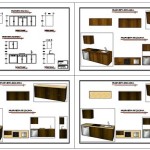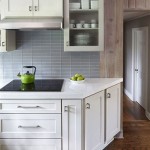How High Should a Kitchen Plinth Be? A Comprehensive Guide
The kitchen plinth, also known as the toe kick, is a seemingly minor detail that plays a crucial role in kitchen ergonomics and aesthetics. Its height impacts user comfort, cabinet longevity, and the overall visual appeal of the kitchen. Choosing the correct plinth height is essential for a functional and enjoyable cooking space.
Standard Plinth Heights
Standard plinth heights typically range from 100mm to 150mm (4 inches to 6 inches). While 150mm is the most common height, the ideal measurement depends on individual user needs and preferences. Taller individuals may benefit from a slightly higher plinth, while shorter individuals might find a lower plinth more comfortable.
Factors Influencing Plinth Height
Several key factors should be considered when determining the optimal plinth height:
User Height
The primary factor influencing plinth height is the height of the primary kitchen users. A plinth that is too low can cause back strain due to excessive bending, while a plinth that is too high can result in shoulder discomfort and reduced reach.
Countertop Height
Countertop height and plinth height are intrinsically linked. The standard countertop height is typically 900mm (36 inches), and the plinth height should complement this measurement to ensure comfortable working postures.
Appliance Integration
Modern kitchens often incorporate integrated appliances like dishwashers and refrigerators. The plinth height must accommodate these appliances seamlessly, ensuring proper ventilation and accessibility.
Accessibility Considerations
For kitchens designed for users with mobility limitations, a higher plinth height may be necessary to accommodate wheelchair or walker access. This allows users to maneuver closer to the countertop without the plinth obstructing their legs.
Aesthetic Impact
While functionality is paramount, the plinth height also affects the overall aesthetic of the kitchen. A carefully chosen plinth height can create a sense of balance and proportion, enhancing the visual appeal of the cabinetry.
Adjusting Plinth Height for Specific Needs
While standard plinth heights offer a good starting point, adjustments may be necessary to accommodate specific user needs. For example, a taller individual might prefer a 175mm (7 inch) plinth for increased comfort, while a shorter individual may opt for a 125mm (5 inch) plinth. Custom plinth heights offer greater flexibility and can be tailored to individual requirements.
Measuring and Installing the Plinth
Accurate measurement is crucial for proper plinth installation. The height should be measured from the finished floor to the underside of the cabinet. The plinth material, typically made of moisture-resistant materials like MDF or PVC, should be cut precisely to fit the space and securely attached to the cabinet base.
Material Considerations for Plinths
Choosing the right material for your kitchen plinth is crucial for its longevity and resilience. Consider the following:
Moisture Resistance
Kitchens are prone to spills and moisture. Opt for water-resistant materials like PVC or moisture-resistant MDF to prevent warping and damage.
Durability
The plinth endures regular contact and potential impacts. Choose a durable material that can withstand daily wear and tear.
Aesthetics
Plinth materials are available in various finishes to match your kitchen cabinets. Select a finish that complements your overall kitchen design.
Importance of Proper Plinth Installation
Correct installation is vital for the plinth's functionality and longevity. Improper installation can lead to instability, moisture damage, and an uneven appearance. Ensuring a secure and level fit is essential for a well-functioning kitchen.
Impact of Plinth Height on Kitchen Ergonomics
Proper plinth height significantly contributes to a comfortable and efficient kitchen workspace. It allows users to stand closer to the countertop without obstruction, reducing strain on the back, shoulders, and legs. A well-designed plinth promotes good posture and minimizes fatigue during meal preparation.
Long-Term Benefits of Choosing the Right Plinth Height
Investing the time to select the appropriate plinth height yields long-term benefits. It enhances user comfort, improves kitchen accessibility, and contributes to the overall aesthetic appeal of the space. A correctly sized plinth is a crucial element of a well-designed and functional kitchen.

Kitchen Worktop Height Everything You Need To Know House Of Worktops

N Standard Kitchen Dimensions Renomart

How To Fit Kitchen Plinths Pelmets Cornices

Kitchen Plinths Advice Please Houzz

Fitting A Kitchen Plinth The Carpenter S Daughter

Do All Integrated Dishwashers Have A Recess Of 150mm Diy Kitchens Advice

Kitchen Worktop Height Depth Wall Unit Dimensions Guide Multiliving Scavolini London

Zurfiz High Gloss Acrylic Kitchen Plinths Kickboards Just Kitchens

Bella Vinyl Kitchen Plinths Kick Boards Made To Measure Just Kitchens

Decorative Plinth Panel For Kitchens Offices Bedrooms 150mm High Aluminium Brushed Brass
Related Posts








